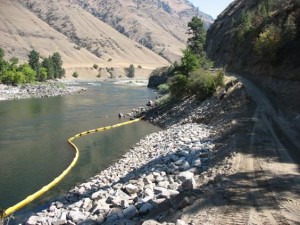Water Conservation
We've all seen them, but did you know that turbidity curtains help maintain a green ecosystem?
We've all seen them, but did you know that turbidity curtains help maintain a green ecosystem?
Turbidity means water that is cloudy, murky or muddy due to sediment, silt and debris getting into the water. All bodies of water will have at least some natural sediment, but certain man-made actions, such as excavation or construction can stir these up and the results can sometimes be harmful. Turbidity curtains were created to keep debris out of the water and prevent accumulation of sediments and silt, therefore, resulting in a greener environment.
 A type one curtain is designed specifically for calm bodies of water, such as canals, small lakes, small ponds and small harbors. It will control turbidity and silt. This type is either 50 to 100 feet long and the depths can be manipulated to fit what the user needs.
A type one curtain is designed specifically for calm bodies of water, such as canals, small lakes, small ponds and small harbors. It will control turbidity and silt. This type is either 50 to 100 feet long and the depths can be manipulated to fit what the user needs.
A type two curtain is designed specifically for controlling turbidity and silt in-water. This is used for pile driving, demolition work, dredging activities, rip-rap installation and other similar activities. This works well in moving water with waves as high as three feet and conditions up to 1.5 knots.
A type three curtain was designed for demanding water conditions. This is what a user would choose to use in rivers, bays, intercoastal waterways and harbors. Long-term projects can be managed with this curtain to keep silt and turbidity maintained. This is ideal for fast-moving waters, rough waves and increased tidal conditions. This works with demolition activities, dredging activities and high-flow construction.
These are helpful anywhere that turbidity and silt need to be contained so that they do not flood a body of water with potentially harmful contaminants. Some common things that will benefit from this curtain include the following:
These curtains are a cost-effective ways to control silt and floating turbidity at the source.
The laws concerning safe environmental practices are constantly evolving and our planet is getting more and more protection every day from new laws and regulations. This type of curtain will help people stay within regulations when it comes to pollution and the environment. Since spoiling local water sources could result in legal action, it is critical to always protect the water when a company is working. Using this type of curtain can help protect against legal action and they are easy to install and move. They are also quite inexpensive.
Bodies of water are constantly working to maintain themselves and the air. When the protected layers at the bottom of a body of water are stirred up, this can make the water body’s work twice as hard, resulting in it not being able to adequately keep potentially harmful things at the bottom.
When there is too much turbidity in a body of water, the organisms already present in the water have the potential to blossom. If these happen to be harmful organisms, they can multiply and make that particular body of water dangerous.
This is especially important in bodies of water that humans and animals frequent, such as places for animals to drink and cool off and where humans swim. Ingesting harmful organisms and pollutants can lead to sickness, and in severe cases, death. Using a turbidity curtain to protect water bodies from excessive sediment and harmful organisms is an easy way to keep those that use the water safe. These curtains essentially keep water environments healthy and act as a barrier for contaminants.
—
About the Author: Mike Zook has been writing about environmental issues for nearly a decade. When he’s not writing, you can find Mike protecting the environment by designing spill containment systems for MPC Containment.
Reply to David Cancel reply